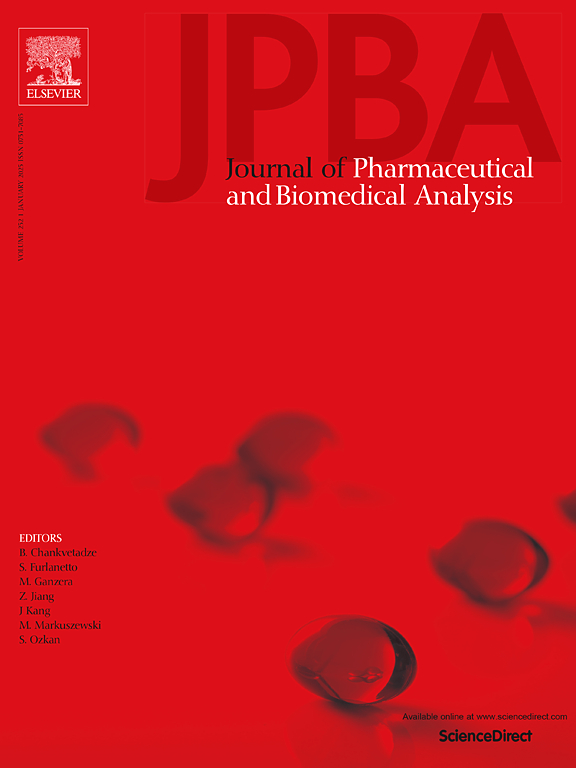龙胆叶的烟熏:其传统用途的验证
IF 3.1
3区 医学
Q2 CHEMISTRY, ANALYTICAL
Journal of pharmaceutical and biomedical analysis
Pub Date : 2025-05-13
DOI:10.1016/j.jpba.2025.116968
引用次数: 0
摘要
黄龙胆的根和根茎被正式列入欧洲药典和众多国家药典,主要用于治疗胃肠道疾病。相比之下,传统上,烟熏叶子用于治疗心绞痛,但缺乏科学支持和其传统用途的理由。因此,本研究对龙胆烟熏前后的化学成分和龙胆叶进行了研究。采用标准化的抽烟机产生卷烟烟雾,并采用高效液相色谱法对其化学成分进行分析。分析表明,相当大比例(68.77 %)的异根素从叶片完整地转移到烟雾流中,使其成为烟雾凝聚物中唯一检测到的化合物。热重分析表明,异根素在250 ~ 448℃的温度范围内发生了热分解。这些发现为龙胆叶的药用潜力提供了科学证据,其中异龙胆素被确定为活性成分。此外,异根皂苷的热稳定性为其燃烧过程中的行为提供了有价值的见解。本文章由计算机程序翻译,如有差异,请以英文原文为准。
Smoking of Gentiana lutea leaves: Validation of its traditional use
The roots and rhizomes of Gentiana lutea L. are officially listed in the European Pharmacopeia and numerous national pharmacopeias and are used mainly to treat gastrointestinal disorders. In contrast, the leaves are traditionally smoked for the treatment of angina pectoris, but scientific support and justification for its traditional use are missing. Therefore, the chemical composition and gentian leaves before and after smoking were investigated in this study. A standardized smoking machine was used to generate cigarette smoke and the chemical constituents were analyzed by high-performance liquid chromatography (HPLC). The analysis showed that a significant proportion (68.77 %) of the xanthone isogentisin was transferred intact from the leaves to the smoke stream, making it the only compound detected in the smoke condensate. Thermogravimetric analysis revealed that isogentisin underwent thermal decomposition within the temperature range of 250–448 °C. These findings provide scientific evidence supporting the medicinal potential of gentian leaves, with isogentisin identified as the active constituent. Furthermore, the thermal stability profile of isogentisin offers valuable insights into its behavior during combustion.
求助全文
通过发布文献求助,成功后即可免费获取论文全文。
去求助
来源期刊
CiteScore
6.70
自引率
5.90%
发文量
588
审稿时长
37 days
期刊介绍:
This journal is an international medium directed towards the needs of academic, clinical, government and industrial analysis by publishing original research reports and critical reviews on pharmaceutical and biomedical analysis. It covers the interdisciplinary aspects of analysis in the pharmaceutical, biomedical and clinical sciences, including developments in analytical methodology, instrumentation, computation and interpretation. Submissions on novel applications focusing on drug purity and stability studies, pharmacokinetics, therapeutic monitoring, metabolic profiling; drug-related aspects of analytical biochemistry and forensic toxicology; quality assurance in the pharmaceutical industry are also welcome.
Studies from areas of well established and poorly selective methods, such as UV-VIS spectrophotometry (including derivative and multi-wavelength measurements), basic electroanalytical (potentiometric, polarographic and voltammetric) methods, fluorimetry, flow-injection analysis, etc. are accepted for publication in exceptional cases only, if a unique and substantial advantage over presently known systems is demonstrated. The same applies to the assay of simple drug formulations by any kind of methods and the determination of drugs in biological samples based merely on spiked samples. Drug purity/stability studies should contain information on the structure elucidation of the impurities/degradants.

 求助内容:
求助内容: 应助结果提醒方式:
应助结果提醒方式:


